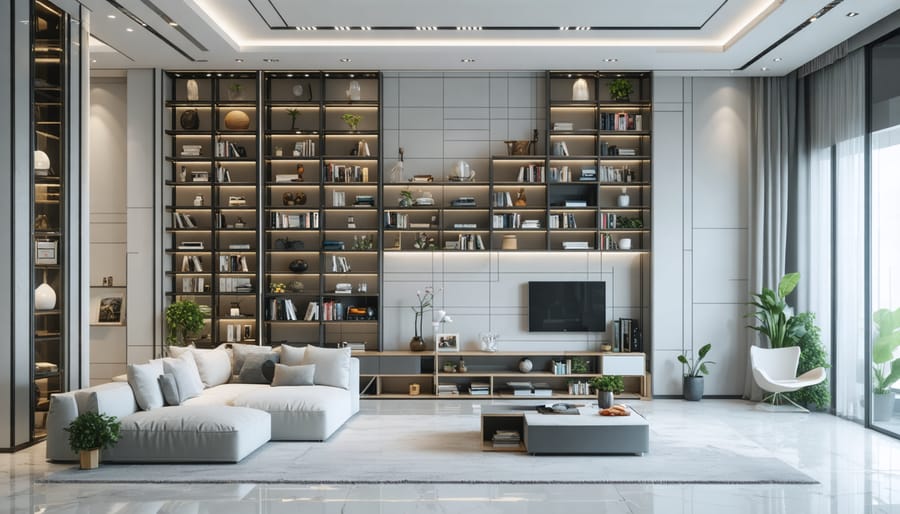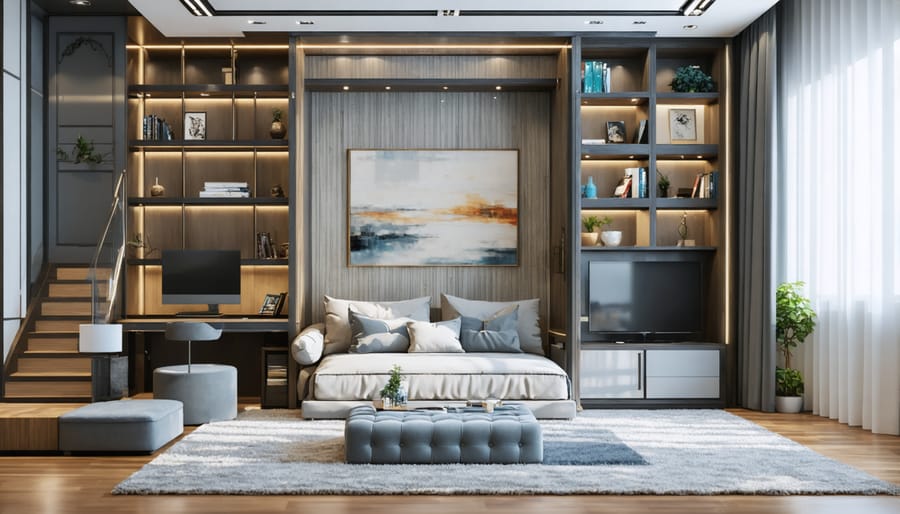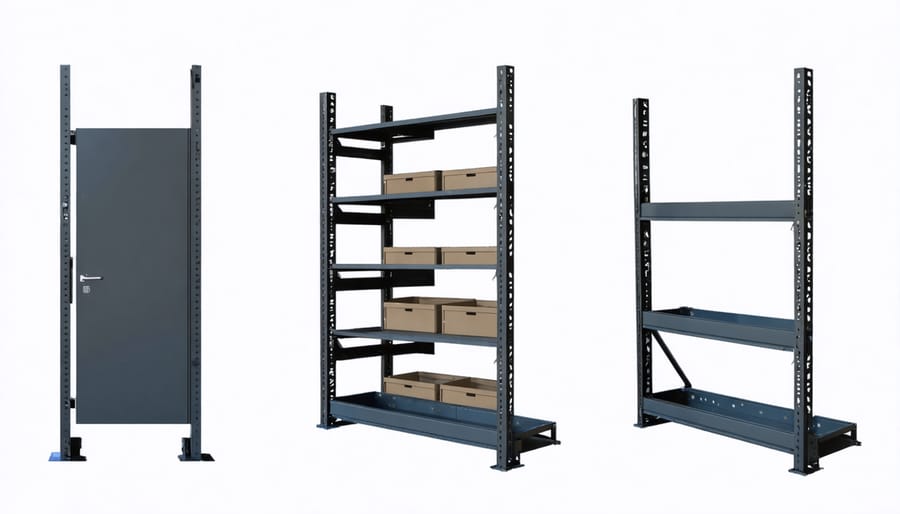Transform your vertical living space into a dynamic, multi-functional environment by strategically utilizing the often-overlooked “z-axis” of your rooms. Stack modular furniture units against walls to maximize small living spaces while maintaining clear pathways. Install floating shelves and wall-mounted storage systems at varying heights to create visual interest and practical storage without consuming floor space. Design convertible zones using retractable furniture and sliding partitions that adapt to different activities throughout the day.
Z-space design revolutionizes how we think about room functionality, treating vertical space as valuable real estate for both storage and living. By embracing this three-dimensional approach, even modest apartments transform into sophisticated, adaptable environments that serve multiple purposes without feeling cramped or cluttered. Whether you’re outfitting a studio apartment or reimagining a family home, mastering z-space principles offers practical solutions for modern living challenges.
This comprehensive guide will walk you through proven strategies to harness your room’s full potential, from selecting space-saving furniture to implementing clever storage solutions that maximize every inch of vertical space.
What Makes Z-Space Design Revolutionary?
Vertical Space Maximization
When it comes to maximizing your living space, looking up can open a world of possibilities. Z-space design excels in utilizing vertical planes, turning previously overlooked wall areas into functional zones. By implementing vertical storage solutions, you can free up valuable floor space while creating organized, accessible storage areas.
Consider installing floating shelves at varying heights to create visual interest while providing practical storage. Floor-to-ceiling bookcases not only maximize storage capacity but also draw the eye upward, making rooms feel taller and more spacious. For smaller spaces, consider mounting fold-down desks or tables that can be tucked away when not in use.
Don’t forget about often-overlooked spaces like the area above doorways or windows. These spots are perfect for displaying decorative items or installing additional storage boxes. In kitchens, extending cabinets to the ceiling eliminates dead space while providing extra storage for seasonal items.
Remember to maintain a balance between functionality and aesthetics. While utilizing vertical space is crucial, avoid overcrowding walls to maintain a clean, organized appearance that enhances rather than overwhelms your living space.
Multi-Dimensional Planning
When planning your z-space design, think beyond just length and width – the secret lies in maximizing every inch of vertical space too. This three-dimensional approach opens up countless possibilities for storage, functionality, and visual interest in your home.
Start by mapping out your space as a cube rather than a flat floor plan. Consider how different elements can stack, hang, or float at various heights. For example, a reading nook might feature floor-level seating, mid-height shelving, and ceiling-mounted lighting to create distinct zones within the same vertical space.
Look for opportunities to layer functions: a loft bed above a work desk, floating shelves that climb up walls, or modular furniture that can be reconfigured vertically. Don’t forget about often-overlooked spaces like the area above doors or windows, which can house additional storage or decorative elements.
The key is to think in layers, creating multiple activity zones within the same footprint. By utilizing wall space effectively and incorporating height variations, you can transform even the smallest room into a multi-functional haven that feels spacious and well-organized.

Practical Z-Space Solutions for Every Room
Living Room Transformations
Transform your living room into a versatile powerhouse by embracing z-space design principles. Start by identifying activity zones that naturally flow into one another. A cozy reading nook can smoothly transition into a home office space, which then evolves into an entertainment area as needed.
Consider furniture that serves multiple purposes: an ottoman with hidden storage that doubles as extra seating, or a console table that unfolds into a dining surface. Wall-mounted furniture pieces are particularly effective in z-space design, as they can be folded away when not in use, instantly creating more floor space.
Moveable room dividers play a crucial role in living room transformations. Use lightweight screens, curtains, or even plants on wheels to create temporary boundaries between different functional areas. These elements can be easily repositioned throughout the day as your needs change.
Lighting is another powerful tool in z-space design. Install adjustable track lighting or smart bulbs that can be programmed for different activities – bright and focused for work, warm and dim for relaxation. Consider floor lamps on wheels that can move with your space configurations.
Pro tip: Create a quick-change furniture layout plan. Mark furniture positions on your floor with removable tape for different scenarios (work, entertaining, relaxation). This makes transitioning between uses smooth and effortless, while maintaining the room’s visual harmony.

Kitchen and Dining Innovations
The kitchen and dining area presents unique opportunities for z-space design, where every inch can serve multiple purposes. Start by considering a foldable dining table that can transform from a compact breakfast nook to a full-sized dining surface for entertaining. Wall-mounted drop-leaf tables are particularly effective, offering flexibility without permanently occupying floor space.
Install sliding pantry shelves that can telescope out when needed and tuck away seamlessly when not in use. These clever storage solutions maximize vertical space while keeping essentials within easy reach. Consider adding a mobile kitchen island that doubles as a prep station and casual dining spot, with built-in storage underneath for rarely-used appliances.
Make the most of corner spaces with rotating carousel shelves or pull-out corner cabinets. These innovative solutions transform traditionally awkward spaces into highly functional storage areas. For smaller kitchens, magnetic knife strips and hanging pot racks free up valuable drawer and cabinet space while keeping cooking tools easily accessible.
Think beyond traditional dining chairs with stackable or nesting options that can be easily stored when not needed. Wall-mounted benches with hidden storage compartments offer comfortable seating while providing space for extra linens or seasonal items. For the ultimate in space efficiency, consider installing a Murphy-style bar that folds down for entertaining and up when you need more floor space.
Remember to incorporate adequate lighting that can adapt to different activities, from food preparation to intimate dining. Under-cabinet LED strips and dimmable pendant lights offer versatility without taking up precious space.
Bedroom and Office Combinations
Combining your bedroom and home office can be a delightful exercise in smart space utilization. The key is creating distinct zones that maintain both the tranquility of your sleeping area and the productivity of your workspace. Start by positioning your desk near natural light, preferably perpendicular to the window to reduce screen glare while maximizing daylight exposure.
Consider using room dividers strategically – a bookshelf, folding screen, or even hanging curtains can help separate your work area from your sleep space. This physical boundary helps maintain work-life balance and creates a psychological distinction between rest and productivity zones. To design the perfect workspace within your bedroom, focus on furniture that serves multiple purposes.
Look for desk solutions that can be tucked away when not in use, such as wall-mounted fold-down desks or wheeled workstations that can be rolled into a closet. Choose a chair that complements your bedroom’s aesthetic while providing proper ergonomic support. Storage is crucial – invest in closed storage solutions that keep work materials out of sight during off-hours, maintaining the peaceful atmosphere essential for good sleep.
Color coordination between your workspace and bedroom decor helps create a cohesive look. Opt for calming neutrals with subtle accent colors that promote both rest and focus. Remember to keep your desk facing away from your bed to minimize work-related stress in your sleep space.
DIY Z-Space Design Projects
Weekend-Friendly Projects
Ready to transform your space this weekend? Here are five quick z-space improvements you can tackle in just a few days without breaking the bank or calling in professionals.
Start with the simplest project: creating a fold-down desk. Mount a sturdy piece of wood to your wall using heavy-duty hinges and a support chain. When not in use, it folds flat against the wall, instantly freeing up your space.
Another weekend-worthy project is installing a murphy-style pet feeding station. Build a simple wooden frame that holds your pet’s bowls and mounts to the wall with hinges. When mealtime’s over, it folds up neatly, keeping your walkways clear.
Transform dead corner space with floating corner shelves. Install them in a zigzag pattern up the wall to create visual interest while maximizing vertical storage. This project typically takes just an afternoon and requires basic tools.
For bedroom organization, try a pull-out clothing rack. Mount a sturdy drawer slide under your bed and attach a clothing rod. This creates hidden storage that pulls out when needed and disappears when not in use.
Lastly, consider building a fold-down laundry drying rack. Using wooden dowels and hinges, create a wall-mounted rack that extends when wet clothes need hanging and folds flat against the wall when done. It’s perfect for small laundry spaces or apartments.
Remember to measure twice and check for studs before starting any wall-mounted project. With basic tools and a can-do attitude, these projects can dramatically improve your space’s functionality.

Custom Storage Solutions
Creating custom storage solutions for your z-space means thinking beyond standard shelving units and cabinets. Start by mapping out your exact storage needs and measuring your available vertical space. Consider incorporating adjustable shelving systems that can adapt as your storage requirements change over time.
Look for opportunities to maximize awkward corners and dead spaces with pull-out organizers or rotating carousel units. Installing track-mounted shelves allows you to modify the layout easily while making the most of your vertical space. Don’t forget to incorporate different storage depths – shallow shelves for smaller items and deeper ones for bulkier belongings.
For maximum efficiency, use clear containers and labels to keep everything organized and easily accessible. Consider adding built-in lighting to illuminate dark corners and make items more visible. Multi-functional pieces, like storage ottomans or bed frames with built-in drawers, can help you maintain a clutter-free environment while preserving your living space.
Remember to leave some breathing room in your storage design – overpacking spaces can make them difficult to use effectively. Plan for about 20% extra space to accommodate future items and make accessing your belongings more comfortable. When designing your storage system, think about your daily routines and place frequently used items within easy reach while storing seasonal or rarely used items in less accessible areas.
Future-Proofing Your Z-Space Design
Creating a space that stands the test of time requires thoughtful planning and strategic design choices. The key to future-proofing your z-space design lies in building flexibility into every element, ensuring your space can adapt as your needs change.
Start with a versatile foundation by choosing neutral colors for major elements like walls and flooring. These provide a timeless backdrop that can easily accommodate changing styles and preferences. Consider modular furniture pieces that can be rearranged or repurposed as needed – think storage ottomans that double as seating or expandable dining tables.
Invest in quality, multi-functional pieces that serve multiple purposes. A Murphy bed system with built-in desk space, for instance, can transform a home office into a guest room in minutes. Install adjustable lighting systems with dimmer switches to create different moods and accommodate various activities throughout the day.
Technology integration is crucial for future-proofing. Plan for adequate power outlets and USB ports throughout the space, and consider installing cable management systems that can handle evolving tech needs. Leave room for technological upgrades by incorporating easily accessible wall cavities or dedicated tech zones.
Storage solutions should be adaptable too. Consider installing adjustable shelving systems and modular closet organizers that can be reconfigured as storage needs change. Use furniture with hidden storage compartments to maximize space efficiency while maintaining a clean aesthetic.
Remember to think about accessibility features that might become important over time. Wide doorways, lever-style handles, and clear pathways aren’t just universal design principles – they’re smart investments in your space’s long-term usability.
Finally, document your space’s infrastructure (electrical, plumbing, and structural elements) to make future modifications easier. This forward-thinking approach ensures your z-space design remains functional and relevant for years to come.
Z-space design is more than just a trendy concept – it’s a practical approach to making your living spaces work harder and smarter for you. By implementing the principles we’ve discussed, you can transform any room into a versatile, multi-functional area that adapts to your changing needs. Remember that successful z-space design doesn’t require a complete home overhaul or expensive renovations. Start small, perhaps with a corner of your living room or that unused nook in your bedroom, and gradually expand your design solutions as you become more comfortable with the concept.
The key is to remain flexible and creative in your approach. Keep experimenting with different layouts, furniture arrangements, and storage solutions until you find what works best for your lifestyle. Whether you’re working with a compact apartment or a spacious home, z-space design principles can help you create more functional, enjoyable living spaces that truly reflect how you live, work, and relax.
